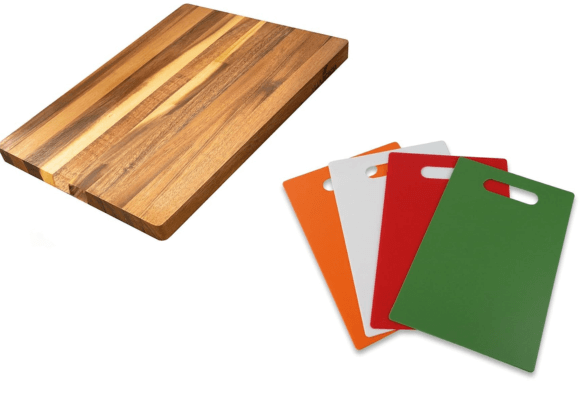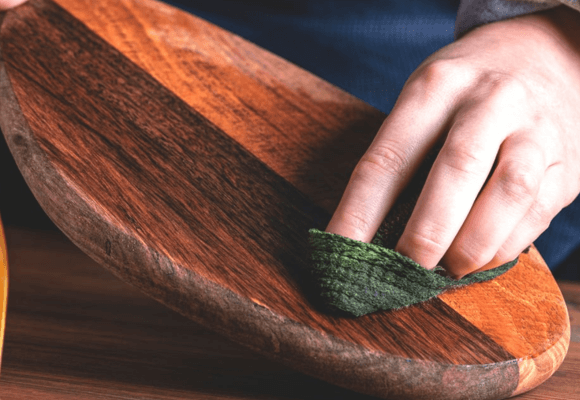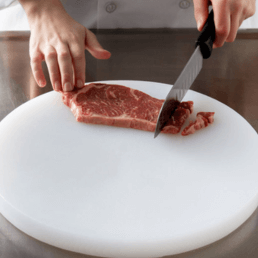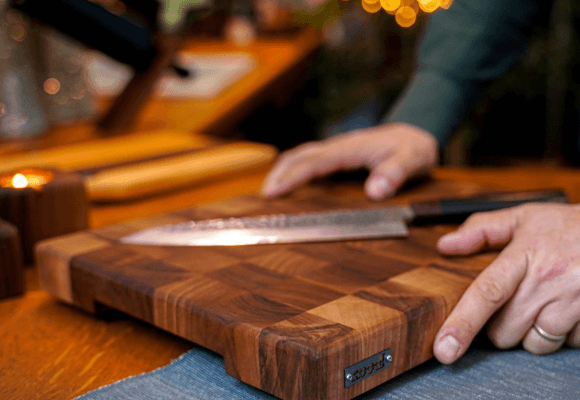Wood or plastic cutting board for meat is a debate that has been going on for a long time and has equal proponents on both sides. But, in this article, for once and all, we will be addressing the debate, considering the importance of selecting the right cutting board for meat and your health.
Many questions arise about why one board is chosen over another or if the same board can be used to cut different chopping materials. Do not worry because we will be shedding light on all these concerns that you have.
A cutting board is often the most overlooked item in the kitchen when it’s essential and is a kitchen tool utilized almost daily. So, which wood or plastic cutting board for meat is ideal?
Wood Or Plastic Cutting Board For Meat
For a long span, all cutting boards were composed of wood. However, then, the notion of introducing other materials came in. As a result, plastic cutting boards came around and were highly regarded by users due to their convenience in cleaning and dishwasher compatibility.
Nevertheless, recent scientific research on the safety of wood and plastic cutting boards has determined that plastic, although easy to clean, is unsafe for use. In comparison to plastic, wood cutting boards are safer.
Understandably, sanitization of a wood cutting board is challenging, considering it cannot be washed in a dishwasher, but wood is a natural and anti-microbial material. The cervices and gouges are inevitable to materialize and serve as housing spaces for plenty of bacteria to hide.
Meanwhile, with wood, despite the innumerable cervices, since they are deep, the bacteria will fall into them and eventually die instead of being nurtured. This means that the chances of bacteria coming into contact with the meat you chop on a wooden cutting board are minimal, contrary to the high chances of bacteria intervention with meat on a plastic cutting board.

Scientific Evidence
An interesting study conducted at the University of Wisconsin Madison has confidently concluded that wood is safe and good, but plastic is dangerous and unhealthy. The researchers initiated an experiment by placing bacteria-contaminated food on wood and plastic cutting boards.
It was found that after three minutes and on a wood-cutting board, all the bacteria in the food were unrecoverable because, presumably, they had died. On the other hand, the case significantly differed for plastic cutting boards, where after three minutes, all the bacteria were recoverable as they had thrived.
Even after the plastic cutting board was washed with soap and hot water, bacteria were discovered to be in good health and in numbers higher than before when contaminated food was placed.
Therefore, these findings rule out plastic boards as fundamentally thriving germ farms, and from a food safety point of view, they are an unsafe option for a cutting board to cut meat.
Maintenance Of A Wooden Cutting Board
Now that the debate has been settled by establishing that wooden cutting boards are a safer and better option than plastic cutting boards for meat, let’s explore some ways to maintain these boards.

Before we proceed, one thing to be remembered about wood cutting boards is that they must never be washed in a dishwasher. This is because the dishwasher’s hot water will expand the wood and eventually lead to its cracking, eliminating all the valuable properties of wood that make it a safe choice as a cutting board for meat.
- If the wooden board has been heavily stained, use lemon juice and salt to clean it. Thoroughly scrub the board, wash it under water, and pat dry with a clean paper towel.
- To remove the bulk of the detritus on the wood, use lukewarm, soapy water. Detergent and warm water are the keys to washing away the dirty surfaces of all your utensils, so it also works desirably for a wood-cutting board. When done, use a clean dish towel to dry the board before storing it.
- In the case that a wood cutting board is continuously utilized for cutting meat, immerse the board in hot water, scrub it using a stiff-bristled brush, and then leave the board to air dry.
- Supposedly, the board has been covered in a thick layer of grease or blood. First, wipe them off with a paper towel, and then use lemon juice and salt paste to scrub the remaining residue. At last, rinse with a soapy water.
- Very frequently, a wooden board is likely to lose its smoothness. Hence, sand down the board with sandpaper to restore the smooth finish.
- When you are not in the mood to thoroughly clean the cutting board but still want to maintain it to ensure longevity, simply clean the board with a sanitizer such as Milton sanitizing fluid.
Preferable Wood For Cutting Board
Agreeably, to some, it may seem strange to choose a wood cutting board that cannot be washed in dishwater or sterilized with heat over a plastic cutting board, which is easier to clean and maintain- the proof is science.
Scientifically, plastic boards are disregarded due to their health concerns. Wooden cutting boards may be demanding in their maintenance, but through their capillary action, they can absorb all bacteria and germs rising from the pores of a cutting surface.
As soon as the bacteria gets trapped within the wood cell, it is immediately deprived of the oxygen it needs to survive and suffocates. Keeping in mind the advantages of a wood cutting board, the National Sanitation Foundation has approved maple wood to be ideal for wooden boards that are to be utilized in the kitchen.
Apart from Maple wood, Beech wood is another safe yet popular choice for manufacturers composing cutting boards. Beech and maple are two distinct kinds of wood that have a remarkable quality of containing a natural resin in them that has antiseptic characteristics, which hinders the growth of bacteria.
Additionally, within beech and maple wood lies another alternative of bamboo wood. Bamboo is inexpensive compared to other kinds of available wood and is a fast-growing grass. This choice, too, is preferred, but sometimes users complain about the hardness of the wood and how it causes their knives to become blunt rather very quickly when they cut meat on a bamboo composed cutting board.
Choosing A Cutting Board Per The Task
Meat, Fish and Poultry
Whenever cutting meat, it is a must for an individual always to use a wood cutting board. The risk of food contamination is significantly lowered through a wood cutting board, and even if some bacteria remain on the board’s surface, sooner rather than later, they will be undiscoverable—all thanks to the wood’s antiseptic qualities.
The same conclusion also applies to cutting fish and poultry. Even though plastic does seem like a tempting choice precisely because it is easier to clean, the long-term effects of using a plastic board for your health are detrimental.

Thus, the trade-off of a wooden board with long-term harmful health effects is beneficial.
Vegetables And Fruits
Plastic and wooden boards both work equally well for cutting vegetables and fruits. Still, the majority of chefs are keen on choosing a wooden cutting board over a plastic one as the repetitive cutting tasks of slicing vegetables and dicing onions will not dull the knife’s sharpness when used on a softer material.
Baked Goods And Bread
The trick of slicing bread or baked goods like cakes and pies can be done with either- plastic or a wooden board. Nonetheless, wood cutting boards here are slightly more advocated for because of their coarser texture that prevents bread and baked goods from slipping when sliced.
Also, if you are concerned about cross-contamination of flavors and odors when using the same wood cutting board for meat and other baked goods, we recommend keeping two separate wood cutting boards for the precise tasks. Your concern is valid; intermixing sweet with savory and vice versa is never a good experience for your taste buds.
Knife-Friendly Features: Wood vs. Plastic
When selecting a cutting board for meat preparation, one crucial factor often overlooked is how the material interacts with knives. The longevity and efficiency of your knives are heavily influenced by the cutting surface you choose. So, there we can try to look how wood and plastic cutting boards affect knives, considering aspects like sharpness retention and overall knife health.

Wood Cutting Boards: Gentle on Knives
Wood cutting boards are renowned for their kindness to knife edges. The soft, yet durable nature of wood provides a forgiving surface for knife blades, minimizing the rate at which they dull. Chopping boards made of Hardwoods like maple, walnut, or cherry are particularly effective in this regard. Their dense grain structure offers enough resistance for efficient cutting while being gentle enough to preserve the sharpness of the blade. This means less frequent sharpening and longer life for your knives.
Another advantage of wood is its natural self-healing property. The fibrous structure can close up minor cuts and scratches, which helps in maintaining a smooth surface that is kind to knife edges. However, this doesn’t imply that wood boards are indestructible; they do require regular maintenance like oiling (mineral oil is a better choice) to keep the wood fibers resilient and prevent cracking, which can otherwise be harsh on knives.
Plastic Cutting Boards: The Harder Choice
Plastic cutting boards, often made from materials like polyethylene or polypropylene, present a harder surface compared to wood. This hardness can be a double-edged sword when it comes to knives. On the one hand, the smooth, non-porous surface of a new plastic board allows for easy and precise cuts. However, over time, the repeated impact of a knife blade can leave significant scratches and grooves in the plastic. These imperfections can be abrasive to knife edges, causing them to dull quicker.
Moreover, plastic boards are less forgiving when it comes to sharpening. While they don’t need the same level of maintenance as wood, their surfaces can become uneven with extensive use, making them increasingly harsh on knife blades. And unlike wood, plastic and glass board doesn’t have self-healing properties, so once the surface is scratched, it stays that way, potentially affecting the longevity of your knives.
Conclusion
Wood or plastic cutting board for meat debate rules out for a wood cutting board to be the most effective and efficient. Plastic boards are a compelling choice in the face of wood due to their affordability and lightweight. Still, when considering health-related concerns and a cutting board, no other material surpasses the benefits yielded by a wood cutting board.
Frequently Asked Questions
Should you cut meat on wood or plastic?
Whether cooked or uncooked, meat should always be cut on a wood cutting board.
Which cutting board is best for meat?
Any board with a nonporous surface or a wood cutting board is best for meat.
Which is better, plastic or wooden cutting board?
Wood cutting boards are considered better than plastic boards as they are safer and do not house bacteria, unlike plastic boards.
Is a wood cutting board safe for meat?
A wood cutting board is not only safe but, so far, the best option for a material to cut meat on.
